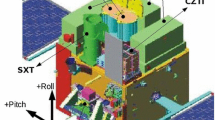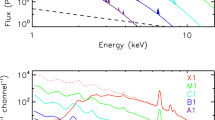Abstract
The article describes the MVN experiment (MVN – Monitor Vsego Neba in Russian transliteration) – All Sky Monitor onboard the ISS, which will start in 2021. The main scientific task of the experiment is to measure the cosmic X-ray background in energy range of 6 – 70 keV with unprecedented high absolute and spectral accuracy (about 1%). To reach this goal, Space Research Institute of the Russian Academy of Sciences has developed scientific payload called MVN. The main instrument of MVN is the SPIN-X1-MVN X-ray monitor, which is equipped with four CdTe based semiconductor detectors. The X-ray monitor will be mounted on the external surface of the ISS with zenith orientation. The structure of the monitor including the key systems (detectors, gears, thermal control system) is considered. Measuring of the cosmic X-ray background is carried out by the aperture modulation method described in detail in this article. Also we describe an optimal algorithm of the obtained in experiment data filtering, which will provide us with highest quality of the CXB measurement.



























Similar content being viewed by others
References
Giacconi, R., Gursky, H., Paolini, F., Rossi, B.: Evidence for X rays from sources outside the Solar system. Phys. Rev. Lett. 9(11), 439–443 (1962)
Giacconi, R., et al.: A high-sensitivity X-ray survey using the Einstein Observatory and the discrete source contribution to the extragalactic X-ray background. Astrophysical Journal Letters 234, L1–L7 (1979)
Ueda, Y., et al.: Toward the standard population synthesis model of the x-ray background: evolution of x-ray luminosity and absorption functions of active galactic nuclei including Compton-thick populations. The Astrophysical Journal, 786. 104 (28pp), 2014. https://doi.org/10.1088/0004-637X/786/2/104
Gilli, R.: The cosmic X-ray background: abundance and evolution of hidden black holes. Mem.Soc.Ast.It. 84, 647–652 (2013)
Mazets, E.P., et al.: Diffuse cosmic gamma-ray background in the 28 keV-4.1 MeV range from Kosmos 461 observations. Astrophys. Space Sci. 33, 347–357 (1975)
Kinzer, R.L., et al.: Diffuse Cosmic Gamma Radiation Measured by HEAO 1. Astrophys. J. 475, 361 (1997)
Churazov, E., et al.: INTEGRAL observations of the cosmic X-ray background in the 5–100 keV range via occultation by the Earth. Astron. Astrophys. 467(2), 529–540 (2007)
Kirsch, M.G.F., Briel U.G., Burrows, D. et al. “Crab: the standart x-ray candle with all (modern) x-ray satellites”, Proc. SPIE 5898, UV, X-Ray, and Gamma-Ray Space Instrumentation for Astronomy XIV, 589803 (18 August 2005). https://doi.org/10.1117/12.616893.
Revnivtsev, M.G.: Measurements of the cosmic X-ray background of the Universe and the MVN experiment. Astron. Lett. 40(11), 667–690 (2014). https://doi.org/10.1134/S106377371411005X
The Russian segment of the ISS. User guide, [online], https://www.energia.ru/ru/iss/researches/iss_rs_guide.pdf, 2016
Sugizaki, M., et al.: In-Orbit Performance of MAXI Gas Slit Camera (GSC) on ISS. Publ. Astron. Soc. Japan 63, S635–S644 (2011)
Vette, J.I. (1991) The AE-8 Trapped Electron Model Environment, NSSDC-91–24, NASA-GSFC
Sawyer, D.M. and Vette, J.I. (1976) AP-8 Trapped Proton Environment for Solar Maximum and Solar Minimum, NSSDC-76–06, NASA-GSFC
Murakami, H., Kitsunezuka, M., Ozaki, M., Dotani, T., Anada, T.: Origins of the instrumental background of the X-ray CCD camera in space studied with Monte Carlo simulation. Proc. SPIE 6266, Space Telescopes and Instrumentation II: Ultraviolet to Gamma Ray, 62662Y (15 June 2006)
Gruber, D.E., Matteson, J.L., Peterson, L.E., Jung, G.V.: The spectrum of diffuse cosmic hard x-rays measured with HEAO-1. Astrophys J 520, 124–129 (1999)
X-Ray Mass Attenuation Coefficients, [online], https://www.nist.gov/pml/x-ray-mass-attenuation-coefficients, 2020
Revnivtsev, M., Sazonov, S., Churazov, E., Forman, W., Vikhlinin, A., Sunyaev, R.: Discrete sources as the origin of the Galactic X-ray ridge emission. Nature 458, 1142–1144 (2009). https://doi.org/10.1038/nature07946
Krivonos, R., Revnivtsev, M., Churazov, E., Sazonov, S., Grebenev, S., Sunyaev, R.: Hard X-ray emission from the Galactic ridge. Astron. Astrophys. 463(3), 957–967 (2007)
Kendrah, D.: Murphy and Tahir Yaqoob “An X-ray spectral model for Compton-thick toroidal reprocessors.” Mon. Not. R. Astron Soc. 397, 1549–1562 (2009)
Doroshenko, V., Santangelo, A., Kreykenbohm, I., Doroshenko, R.: The hard X-ray emission of X Persei. A&A 540, L1 (2012). https://doi.org/10.1051/0004-6361/201218878
Serbinov, D.V., Semena, N.P., Pavlinsky, M.N.: Opposite Radiators Used for Thermostabilizing of X-Ray Detectors of the All-Sky Monitor to be Installed on the ISS. J. Eng. Thermophys. 26(3), 366–376 (2017)
Acknowledgments
The work was supported by the grant 14.W03.31.0021 of the Ministry of Science and Higher Education of the Russian Federation.
Author information
Authors and Affiliations
Corresponding author
Additional information
Publisher’s note
Springer Nature remains neutral with regard to jurisdictional claims in published maps and institutional affiliations.
Rights and permissions
About this article
Cite this article
Serbinov, D.V., Pavlinsky, M.N., Semena, A.N. et al. MVN experiment – All sky monitor for measuring cosmic X-ray background of the universe onboard the ISS. Exp Astron 51, 493–514 (2021). https://doi.org/10.1007/s10686-021-09699-8
Received:
Accepted:
Published:
Issue Date:
DOI: https://doi.org/10.1007/s10686-021-09699-8




